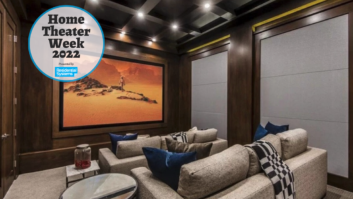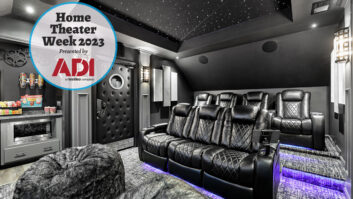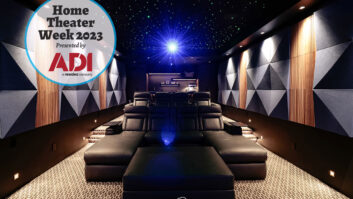Frank Lloyd Wright is the one name that is synonymous with innovative 20th Century American residential architectural design. And, if there is one name that is equivalent to Wright’s within the narrow niche of American home theater architectural design, it is Theo Kalomirakus. Those two names came together, recently, on a project that was named CEDIA’s Best Home Theater Architecture winner at EXPO 2002, by representatives of the American Institute of Architects. The dedicated home theater, built in a home in Jupiter, Florida, was designed by the legendary Kalomirakus and featured a Frank Lloyd Wright-inspired aesthetic. Kalomirakus’ decision to turn to a residential architecture master for design inspiration, was initially a result of his effort to tie the theater’s design with that of the rest of the South Florida art deco home.
“I try to impress upon a client that the theater style should tie in with what is going on in the rest of the house,” Kalomirakus explained. “There are so many times when clients will say, ‘I’d love an art deco theater or a traditional theater, because I saw one in a magazine, and it was spectacular.’ Usually if what they have in mind doesn’t really go with the house, I try to convince them that putting something that is an alien object in the house has a translation of making the theater look like a cartoon.”
In this particular case, the Florida home already consisted of many contemporary/art deco elements, so designing an deco theater was not out of the question. To make the theater unique enough to stand on its own, however, Kalomirakus suggested that the homeowner abandon ornate flourishes and go with the streamlined art deco “architectural language” instead.
The decision also served as a unique personal challenge for Kalomirakus who not only considers Wright as one the greatest architects of the previous century, but because the master had never designed anything in the “theater mode” that was successful. “He had done three or four [commercial theater designs] but it was always, in my mind, something to which he didn’t really pay much attention. It wasn’t his forte. The three or four theaters that we’ve seen in his book are not up to par with what he has done,” Kalomirakus said.
So it was up to Kalomirakus to set the standard for this style of theater design, or in essence to “out Frank Lloyd Wright” Frank Lloyd Wright. “It was kind of a silly little challenge to myself,” Kalomirakus said. “But, it’s a tricky project because there was a lot of woodwork that had to be balanced with acoustical treatments.” In addition to the reflective wood columns, the theater’s ceiling was an unusually high 11 1/2 feet. Because the room itself was not very big, leaving the ceiling as is would have resulted in an “elevator shaft-like” design.
“I used the opportunity to bring the ceiling down-not to just grab it and stretch it down, but to articulate it,” Kalomirakus explained. “We were allowed to design a more architecturally interesting ceiling, but we also created a big diffuser up there that helped the acoustics and also helped us to hide the projector.”
Kalomirakus kept the room’s color palette subdued, which is counter to the much more garish patterns and colors seen in the typical Hollywood deco “tributes” found in most home theater designs. “People get very excited about their designs, and you have to run for cover sometimes,” Kalomirakus said of the typical red and gold displays in so many contemporary designs. “It happened in the old theaters as well. You go to some old theaters and everything but the kitchen sink is on the wall. One of my goals, generally in this business, is to try to avoid the trap of being too ‘loud’ with my designs.”
In another personal design challenge, Kalomirakus chose to create an asymmetrical room, which is also atypical of standard theater layout, which tends to thrive in utter symmetry.
“To break the symmetry, I have things that are off-the left side doesn’t look like the right side,” Kalomirakus noted. “However, there is an underlining symmetry that allows you to play with breaking the facade symmetry and still have something that’s harmonious.” In addition to an “off-balance” proscenium, asymmetrical baffles were located in the back of the room and an entry corridor was placed on only one side of the room. “We put the corridor on the side that incorporated a bar area. It also allows you get an entry into the theater through something that’s thematically tied with the room,” Kalomirakus said.
This particular aspect of the asymmetrical design provided Audio Advisors of West Palm Beach with their own set of challenges as they integrated the A/V into the system. “With the one side of it open to the bar area and the other side closed, there wasn’t a whole lot we could do about it acoustically other than put some diffusers in and some absorptive material on some of the exterior walls,” said Audio Advisors’ director of system design, Eric Bergstedt. “We tried to compromise and find a happy medium for acoustics. We both gave a little to get a little.”
From an architectural design standpoint, “throwing symmetry out the window” was a true challenge for Kalomirakus. “I thrive in symmetry in this business, and my colleagues do as well,” he explained. “With this design I said, ‘let’s do it asymmetrically like a modern painting.’ When you see a Picasso painting it’s very aesthetically pleasing, even though you don’t have that kind of classical symmetry.” For Kalomirakus, the new design concepts used in his award-winning project, helped him to avoid stagnation as an architect. “If you’re given a box, it’s so easy to just put decoration on the wall that you may as well not do it,” he said. “For me, anything that is ‘off’ actually provides a real departure for something different.”
Jeremy Glowacki is editor of Residential Systems.







